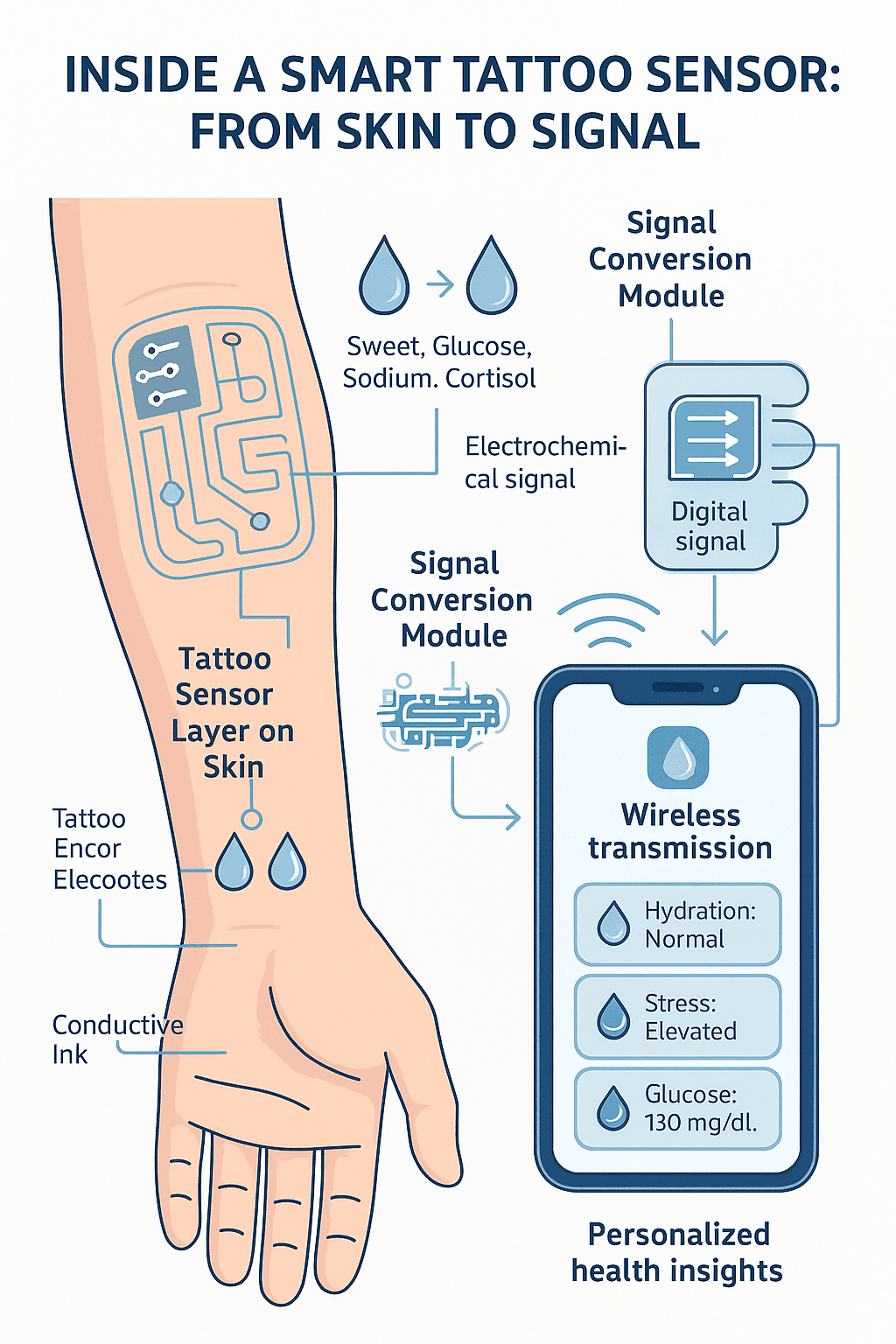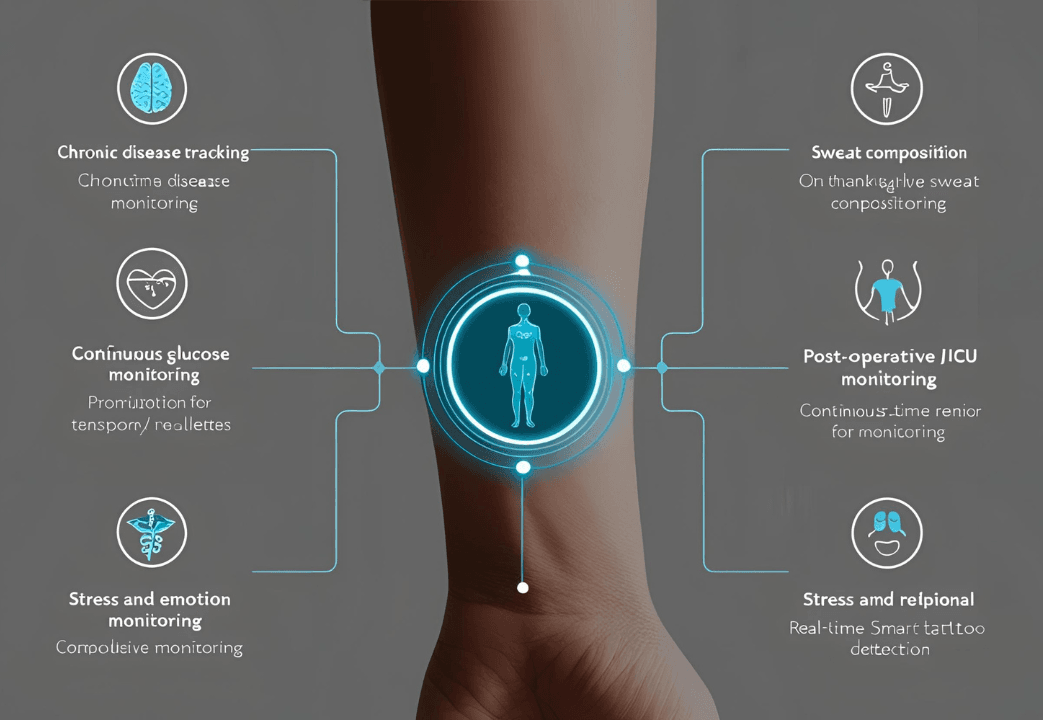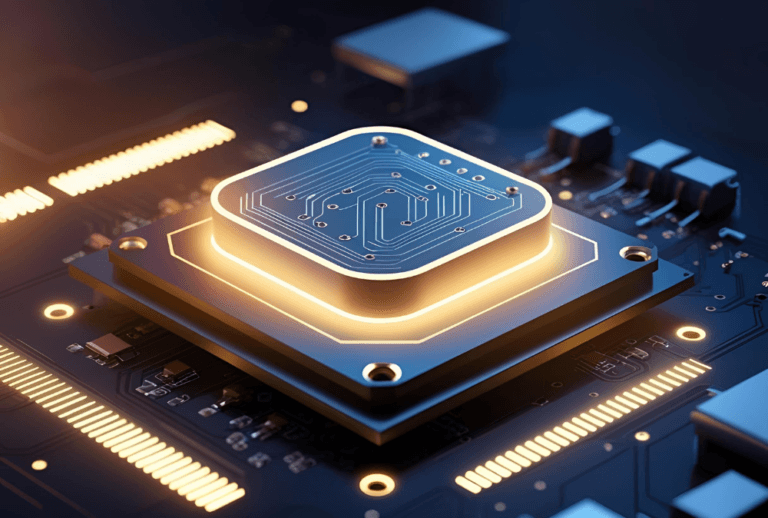🧬 Introduction to Smart tattoo sensors: From Ink to Innovation
Once a symbol of art or rebellion, tattoos are now entering the world of biotech. Smart tattoo sensors—also called electronic tattoos—represent a bold new leap in wearable technology. These are ultra-thin, flexible circuits that can be printed or embedded onto your skin like temporary tattoos, but with one major upgrade: they can read your body’s vital signs in real-time.
Unlike conventional wearables like smartwatches or fitness bands, smart tattoo sensors offer continuous, skin-level monitoring without the bulk. They’re more intimate, less intrusive, and can sit closer to the action—your muscles, sweat glands, or even neural pathways.

These electronic tattoos aren’t just about measuring heart rate or hydration. They’re poised to become the next-gen Wearable health technology—capable of tracking glucose levels, detecting emotional states through electrodermal signals, and even sending alerts to your doctor without you lifting a finger.
Imagine a tattoo that warns you of a panic attack before it happens. Or one that syncs with your smart home, dimming the lights when your stress levels spike. That’s not science fiction—it’s the early reality of smart tattoo sensors.
As we dive deeper, you’ll see how this tech is merging biology and electronics to bring us closer to a seamless, responsive future.
🔬 How Smart Tattoo Sensors Work
Smart tattoo sensors represent the fusion of biology and technology, bringing wearables to a whole new level. Unlike traditional wearables, these biosensor tattoos are lightweight, flexible, and capable of seamlessly integrating into the skin. Here’s a scientific breakdown of how they function:
🧬 Biocompatible Polymers and Conductive Materials
At the heart of smart tattoo sensors are biocompatible polymers and conductive materials. These materials ensure the tattoos are safe for long-term wear, minimizing irritation and inflammation. Graphene, a single layer of carbon atoms, is commonly used for its conductivity and flexibility. This allows the tattoo to maintain electrical properties even as the skin stretches or moves. These materials are also eco-friendly, ensuring they don’t harm the environment or the skin’s microbiome.
🧪 Integration of Flexible Circuits
The core technology behind these skin-based electronics is the integration of flexible circuits. Unlike hard, rigid electronics in devices like smartphones or smartwatches, these tattoos are made from soft, flexible substrates—similar to human skin. Printed electronics are embedded directly into the tattoo, allowing it to bend and stretch with the skin’s natural movements, offering comfort and precision. This flexibility is essential for continuous, real-time monitoring without discomfort or obstruction.
🌡️ Sensor Types: Temperature, Glucose, Hydration, pH, and More
One of the key advantages of smart tattoo sensors is their multi-sensor capabilities. These tattoos can measure a variety of biological markers, including:
- Temperature Sensors: Monitoring body heat for signs of fever or infection.
- Glucose Sensors: Offering continuous glucose monitoring for diabetics.
- Hydration Sensors: Keeping track of hydration levels during exercise or hot weather.
- pH Sensors: Detecting changes in the skin’s acidity, which could indicate stress or illness.
Each of these sensors is embedded within the tattoo, communicating directly with an app or device to offer Real-time biometric monitoring. The data generated can be used for early disease detection, personalized wellness, and predictive health management.

💡 Illustration Suggestion
To make this clearer for your readers, consider including an illustration with a layered diagram. Show how the biosensor tattoos sits atop the skin, with arrows pointing to the embedded electronic circuits and sensor types like glucose and hydration. This visual would help your audience visualize how the tattoo functions at both the biological and technological levels.
⚙️ Types of Electronic Tattoos
The world of electronic tattoos is diverse and rapidly evolving, with different materials and mechanisms catering to specific use cases. These e-skin sensors combine ultra-thin materials with high-performance sensors, bringing medical diagnostics, personal health tracking, and human-machine interfaces directly onto the skin. Let’s explore the main types:
🧪 Graphene Tattoos
Graphene electronic tattoos are among the most promising due to graphene’s extraordinary properties: ultra-thin, flexible, transparent, and highly conductive. These tattoos can monitor vital signs like electrical brain activity (EEG), hydration, and respiration. A notable study by the University of Texas at Austin demonstrated graphene e-tattoos that can continuously monitor heart signals (ECG) with clinical-grade accuracy, outperforming bulkier traditional devices.
🥇 Gold Leaf E-Tattoos
Ultra-thin gold leaf tattoos use sheets of real gold just microns thick. Their primary advantage is biocompatibility and seamless skin integration. These electronic tattoos function as motion sensors, detecting muscle activity or facial expressions. Research from Japan’s University of Tokyo showed gold e-skin sensors could endure repeated flexing and stretching without degradation, making them ideal for long-term wear.
🧫 Electrochemical Biosensors
These e-skin sensors use enzymes and nanomaterials to detect specific biomarkers like glucose, lactic acid, or alcohol in sweat. They operate via redox reactions that generate electrical signals when target molecules are detected. Electrochemical tattoos are especially valuable in non-invasive medical diagnostics, offering a needle-free alternative for diabetics. A 2020 paper in ACS Sensors highlighted enzyme-integrated tattoos capable of real-time blood sugar tracking through sweat.
📡 NFC-Based Tattoos
Near Field Communication (NFC) tattoos allow wireless data transfer without batteries. Activated by smartphones or scanning devices, these tattoos can upload biometric data instantly. They’re especially useful for medical ID tattoos, where a scan could reveal allergies, medications, or emergency contact info. Researchers at MIT Media Lab explored NFC tattoos for both health tracking and secure data sharing.
🔀 Hybrid Smart Tattoos
Some advanced electronic tattoos combine multiple sensors into a single patch. For example, a hybrid e-tattoo might monitor UV exposure, hydration, and temperature at once, offering a full profile of your skin health. Researchers from Caltech and UCLA have co-developed a multifunctional wearable patch that seamlessly integrates UV exposure sensors, sweat biomarker analysis, and motion tracking—paving the way for real-time preventive care and hyper-personalized health insights.
Electronic tattoos are no longer science fiction—they’re a transformative layer of skin-based electronics already reshaping how we interact with our bodies and environments. Whether you’re interested in fitness, chronic disease monitoring, or real-time diagnostics, the evolving landscape of e-skin sensors offers a flexible future.
🏥 Applications in Real-Time Health Monitoring
Smart tattoo sensors are rapidly transforming the landscape of real-time health monitoring, making continuous, non-invasive diagnostics a reality. Unlike conventional wearables, these skin-integrated electronics offer a more intimate, accurate, and responsive form of wearable health technology. Here’s how they’re revolutionizing healthcare across various domains:
💉 Chronic Disease Tracking
For individuals managing chronic diseases such as diabetes or cardiovascular conditions, Biosensor tattoos offer unprecedented potential. Real-time health monitoring of glucose, blood pressure, and heart rhythms allows for early warnings, medication adjustments, and better lifestyle decisions. In particular, electrochemical tattoo biosensors can track glucose through sweat—eliminating the need for finger-prick tests.
🍬 Continuous Glucose Monitoring
Electronic tattoo sensors equipped with glucose-detecting enzymes are now capable of providing continuous glucose monitoring (CGM). Unlike traditional CGM devices, these tattoos are ultra-thin, flexible, and discreet, making them ideal for all-day wear. A 2022 study published in Biosensors and Bioelectronics demonstrated skin-applied patches that accurately tracked blood sugar levels in real time, alerting users via their smartphones.

🏃♂️ Sweat Composition for Athletes
Top-tier athletes are leveraging cutting-edge wearable biosensors to fine-tune their physiology, optimize recovery, and gain a competitive edge at the limits of human performance. Smart tattoos can monitor sweat composition, measuring hydration, electrolytes, and lactic acid buildup. These insights can prevent dehydration, cramps, and fatigue before they occur. For example, the Gatorade Gx Sweat Patch uses similar principles to help athletes optimize hydration strategies during workouts.
🏥 Post-Operative and ICU Monitoring
In clinical settings, real-time health monitoring is critical—especially for patients recovering from surgery or in intensive care. Smart tattoo sensors can continuously track vitals like body temperature, oxygen saturation, and heart rate, sending real-time alerts to medical teams. This approach can lighten the burden on ICU staff and enhance patient recovery, all while eliminating the discomfort associated with traditional wires and electrodes.
😰 Stress and Emotion Detection
Beyond physical health, smart tattoos are now being explored for psychophysiological monitoring. By measuring biomarkers like cortisol and skin conductance, these devices may detect stress levels and emotional shifts. Future applications include mental health support, burnout prevention, and even emotion-aware wearables that adapt your environment based on mood.
As smart tattoo technology matures, its role in real-time health monitoring will only expand—making healthcare more proactive, personalized, and preventive. These invisible guardians could soon become a normal part of our daily wellness routines.
🧪 Biosensor tattoos in Action: Case Studies & Prototypes
Smart tattoo applications are no longer confined to sci-fi or concept labs—they’re making real-world appearances through pioneering research and early prototypes. Here are some standout examples proving this tech’s potential:
🧠 UT Austin’s Graphene “E-Tattoos”
Engineers at the University of Texas at Austin have developed ultra-thin graphene-based electronic tattoos that can measure blood pressure and stress levels with clinical-grade accuracy. These tattoos are lightweight, stick directly to the skin, and use electrical bioimpedance to track cardiovascular signals in real time. Their use could dramatically improve hypertension management without traditional cuffs.
☀️ L’Oréal’s UV Sensor Tattoo
Cosmetic leader L’Oréal teamed up with wearable technology specialists to introduce My UV Patch, a flexible sensor designed to monitor ultraviolet (UV) exposure on the skin. The patch changes color based on sun intensity and connects to an app that educates users about safe sun habits. It’s one of the first mainstream smart tattoo applications focused on consumer wellness and skin cancer prevention.
💉 Harvard’s Biosensing Ink
At Harvard’s Wyss Institute, researchers created biosensor tattoo ink that changes color based on body chemistry. This ink is capable of detecting glucose levels, signs of dehydration through sodium concentration, and fluctuations in pH. The tattoo ink turns dark green when glucose is high, offering a revolutionary concept for diabetes monitoring without electronics. It’s a prime example of how smart tattoo applications may blend art and biomedicine.
🤝 Pilot Studies and Collaborations
Collaborative efforts between universities, healthcare institutions, and tech firms are accelerating the development of smart tattoos. Initiatives like MIT’s bio-ink programs, South Korean nanotech labs, and cross-sector pilots are paving the way for FDA approvals, consumer testing, and real-world deployment.
From monitoring glucose levels to tracking UV exposure and cardiovascular health, these smart tattoo technologies are progressively turning theoretical possibilities into practical, everyday healthcare solutions.
🚀 Companies and Startups Leading the Tattoo Tech Movement
The rise of wearable biosensor companies and electronic skin startups is fueling the smart tattoo revolution. These innovators are merging biotech, nanomaterials, and flexible electronics to create the next generation of skin-based diagnostics and communication tools.
🧬 Chaotic Moon Studios
Known for pushing the boundaries of tech-art, Chaotic Moon showcased a prototype called “Tech Tats.” These smart tattoos use electroconductive ink to collect biometric data like body temp and heart rate. While still experimental, the concept revealed how wearable biosensor companies could embed ID, medical, and fitness functions right into your skin.
📡 MC10 – BioStamp
MC10’s BioStamp is a flexible sensor patch that adheres like a tattoo and monitors movement, temperature, and muscle activity. Originally developed for sports performance and physical therapy, this device is now explored for post-surgical and neurological tracking. MC10 represents the transition from lab innovation to medical-grade wearables.
☀️ L’Oréal – My UV Patch
L’Oréal’s My UV Patch may seem cosmetic, but it’s one of the first mass-produced electronic skin startups to enter the consumer market. Its success proves that health-aware wearables can be fashionable, affordable, and medically relevant.
🧠 Xsensio
Swiss startup Xsensio is developing Lab-on-Skin™, a wearable patch that measures stress hormones, electrolytes, and metabolic markers in real time. Their biosensor platform uses smart skin interfaces and advanced analytics, aligning closely with the vision of continuous, skin-level diagnostics.
🎓 Academic Powerhouses
R&D teams at MIT, Stanford, and institutions in South Korea are developing the material science and biointerface engineering behind smart tattoos. These universities serve as the launchpads for spinoffs and patents fueling the startup ecosystem.
Wearable biosensor innovators and electronic skin startups are pioneering a future where real-time health data moves effortlessly from our skin to digital platforms—and potentially, directly into the hands of doctors and intelligent AI systems for instant insights and interventions.
📈 Market Potential and Industry Forecasts
The smart tattoo market is poised to redefine the wearable biosensor industry, with forecasts signaling exponential growth across healthcare, consumer tech, sports, and even military sectors. What began as experimental research is quickly evolving into a commercially viable frontier.
📊 Global Growth Outlook
Market analyses from Fortune Business Insights and IDTechEx project that the smart tattoo industry will exceed $5 billion in valuation by 2030, driven by a robust compound annual growth rate (CAGR) of approximately 21–24%, reflecting growing demand for seamless, skin-integrated health monitoring technologies. This surge is fueled by increasing demand for non-invasive health monitoring, personalized wellness tracking, and human-machine interfacing.
🏥 Healthcare Sector
The healthcare segment remains the dominant force. Smart tattoos enable real-time tracking of vital biomarkers—glucose, hydration, electrolytes, and stress hormones—critical for managing chronic diseases like diabetes, cardiovascular conditions, and neurological disorders. Hospitals, telemedicine providers, and clinical trial companies are beginning to explore these technologies for continuous patient monitoring.
🏃♂️ Sports and Fitness
Athletes are adopting wearable biosensor technology for performance optimization. Smart tattoos provide insights into lactic acid, dehydration, and muscle fatigue—metrics that wearable bands often miss. Sports tech firms and Olympic training programs are funding research to embed tattoo sensors into daily regimens.
🪖 Military and Defense
In defense, the U.S. Department of Defense and allied agencies are researching biosensor tattoos to monitor soldier fatigue, hydration, and stress in real time. The ability to assess battlefield vitals without bulky gear is a major advantage.
🧠 Big Tech & Pharma
Tech giants like Google (Verily), Apple, and Samsung are rumored to be investing in e-skin interfaces and biosensor platforms. Pharma leaders like Roche and Johnson & Johnson are exploring tattoo-based diagnostics for decentralized trials and drug adherence tracking.
As the wearable biosensor industry evolves, smart tattoos are fast becoming the skin-deep tech layer bridging health, performance, and digital interactivity.
🚀 Beyond Health: The Visionary Future of Skin Interfaces
Imagine your skin as a futuristic wearable tech interface—a canvas that glows with data, controls your environment, and changes color with your mood. That’s the promise of digital skin sensors and the next generation of smart tattoos.
🕹️ Skin as an Input Device
Forget keyboards and touchscreens—smart tattoos could let you control devices with a wave of your hand. Gesture-controlled tattoos using near-field communication (NFC) or capacitive sensors could enable virtual typing, drone piloting, or even operating smart appliances with simple finger movements.
🧠 Emotion-Sensing Tattoos
Future iterations of smart tattoos could feature electrodermal activity sensors and hormone-level monitors capable of interpreting emotional states—offering real-time insights into stress, anxiety, or mood fluctuations through subtle physiological signals. These tattoos could respond visually—changing colors or patterns—helping people with autism or anxiety better understand their emotional states or communicate non-verbally.
🌈 Mood- and Pathogen-Responsive Ink
Research is ongoing into biosensitive inks that react to internal biochemistry or environmental triggers. Tattoos could shift color when you’re dehydrated, stressed, or exposed to harmful pathogens—functioning as an early warning system for illness or infection.
🏡 Tattoos that Link to Smart Homes
Picture a tattoo that syncs with your smart home—dimming lights when your stress spikes, adjusting room temperature based on your body heat, or unlocking your front door with a pulse pattern. This vision is already being prototyped in labs working on bio-integrated electronics.
🌐 Merging with AR/VR Worlds
Digital skin sensors could bridge real and virtual realities. In AR/VR environments, your tattoo could serve as a login, a haptic feedback device, or a visual avatar extension. Gaming, education, and therapy could all benefit from this skin-to-screen interface.
🧬 The Sci-Fi Frontier
Looking forward, tattoos may carry digital DNA, encrypt medical history, or evolve with AI to adapt to your body’s changing needs. From real-time diagnostics to emotion-aware computing, these applications blur the line between biology and machine in the most intimate way possible—your own skin.
As this futuristic wearable tech landscape unfolds, smart tattoos are becoming not just tools, but companions—silent, responsive, and as alive as the people who wear them.
⚠️ Challenges, Risks, and Ethical Questions
As electronic tattoos become more prevalent in medical, consumer, and even social spaces, the discussion around electronic tattoo safety and bioethics in wearable tech becomes critical. Innovation must be matched with responsibility.
🧪 Biocompatibility and Long-Term Effects
One of the primary concerns is biocompatibility. While most smart tattoo sensors use skin-friendly substrates like graphene or gold leaf, long-term skin contact—especially with adhesive or ink-based designs—can cause irritation, allergic reactions, or inflammation. The cumulative effect of multi-day wear remains under-researched, especially in sensitive skin populations.
🤕 Skin Irritation and Tattoo Wear-Out
Wear and tear is another concern. As these devices flex with your body, sweat, UV exposure, and physical activity can degrade their performance. Smart tattoos must be designed for both durability and skin comfort to avoid rash-like reactions or loss of function after a few days.
🔒 Who Owns Your Data?
Biometric data—glucose levels, stress markers, even your heart rhythm—is deeply personal. As wearable biosensors become more advanced, questions around data privacy intensify. Who stores your data: your doctor, the app developer, or a third-party cloud server? Could insurers or employers access it to make decisions about your risk profile?
🌍 Social and Cultural Dimensions
Not everyone views tattoos as purely functional. In many cultures, tattoos carry deep social, religious, or generational meaning. Introducing tattoo tech into this space risks cultural insensitivity or creates new biases—especially if access to such tech becomes a marker of status or privilege.
From electronic tattoo safety to the bioethical implications of body-integrated sensors, the future of smart tattoos must balance innovation with respect for human autonomy, consent, and societal diversity.
✅ Conclusion: Are We Ready for Digital Skin?
Smart tattoo sensors are more than just next-gen wearables—they’re digital skin interfaces with the potential to transform how we track health, communicate, and interact with technology. From ICU rooms to living rooms, they promise a world where skin itself becomes a diagnostic tool, a controller, or even an emotional display.
As these Wearable health technology evolve, so too must our frameworks for safety, privacy, and ethical usage. Their benefits are clear—continuous health tracking, disease prevention, and enhanced human-computer interaction. But the questions we now face are equally vital: Who governs this data? How do we ensure accessibility? At what point does technology stop assisting biology and start becoming part of it?
“The body has always been an interface. Smart tattoos just make that literal.”
The future of digital skin is closer than we think. Are we ready to wear our tech not just on our wrists—but woven into the very surface of who we are?
Explore, question, and stay tuned—because the skin you’re in may soon be your most powerful device.
🔗 Curious About What’s Next in Wearable Tech?
If smart tattoos blew your mind, wait until you explore these:
-
💧 Wearable Sweat Sensors Are Revolutionizing Wearable Tech – From hydration to stress, your sweat reveals it all.
-
🧠 Neural Dust and the Smart Home Revolution – Tiny brain sensors that could change how we live and think.
-
📡 Neurograins: Wireless Brain Chips and the Rise of Collective Intelligence – A look at how the brain might one day connect to the cloud.
- 🩻 Electronic Skin: The Next Frontier in Human-Machine Interfaces – Ultra-sensitive synthetic skin that mimics real touch and transmits health data.
- 👕 E-Textiles: Where Fabric Meets Function in Future Fashion – Smart clothing that tracks, reacts, and even powers devices as you move.






